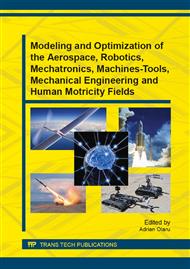[1]
N. Peters: Turbulent Combustion (Cambridge Univ. Press, Cambridge, U.K. 2000).
Google Scholar
[2]
B. Gherman, F.G. Florean, I. Porumbel and C. Cârlănescu: On the influence of the combustion model on the results of turbulent flames numerical simulations, GT2012-69255: Proc. ASME Turbo Expo Conf. (2012).
DOI: 10.1115/gt2012-69255
Google Scholar
[3]
F.C. Christo, A.R. Masri and E.M. Nebot: Artificial neural networks implementation of chemistry with PDF simulation of H2/CO2 flames: Comb. Flame, Vol. 106, p.406 (1996).
DOI: 10.1016/0010-2180(95)00250-2
Google Scholar
[4]
J.A. Blasco, N. Fueyo, C. Dopazo and J. Ballester: Modelling the temporal evolution of a reduced combustion chemical system with an artificial neural network: Comb. Flame, Vol. 113, p.38 (1998).
DOI: 10.1016/s0010-2180(97)00211-3
Google Scholar
[5]
J.A. Blasco, N. Fueyo, J. C. Larroya, C. Dopazo and J.Y. Chen: A single-step time-integrator of a methane air chemical system using artificial neural networks: Comp. Chem. Engr., Vol. 23, p.1127 (1999).
DOI: 10.1016/s0098-1354(99)00278-1
Google Scholar
[6]
F.C. Christo, A.R. Masri, E.M. Nebot and S. Pope: An integrated PDF / neural network approach for simulating turbulent reactive systems: Proc. Comb. Inst., Vol. 26, p.43, (1995).
DOI: 10.1016/s0082-0784(96)80198-6
Google Scholar
[7]
J.Y. Chen, J.A. Blasco, N. Fueyo and C. Dopazo: A single-step time-integrator of a methane air chemical system using artificial neural networks: Proc. Comb. Inst., Vol. 28, p.115 (2000).
DOI: 10.1016/s0098-1354(99)00278-1
Google Scholar
[8]
R. Kapoor, A. Lentati and S. Menon: Simulations of methane - air flames using ISAT and ANN. AIAA-2001-3847(2001).
DOI: 10.2514/6.2001-3847
Google Scholar
[9]
R. Kapoor and S. Menon: Computational issues for simulating finite - rate kinetics in LES: Proc. Turbo Expo Conf. (2002).
DOI: 10.1115/gt2002-30608
Google Scholar
[10]
F. Flemming, A. Sadiki and J. Janicka: LES using artificial neural networks for chemistry representation: Proc. 21st German Flameday Conf. (2003).
Google Scholar
[11]
F. Sarghini, G. de Felice and S. Santini: Neural networks based subgrid scale modeling in large eddy simulations: Comp. Fluids, 32, p.97 (2003).
DOI: 10.1016/s0045-7930(01)00098-6
Google Scholar
[12]
Y. Choi and J.Y. Chen: Fast prediction of start-of-combustion in HCCI with combined artificial neural networks and ignition delay model: Proc. Comb. Inst., Vol. 30, p.2711 (2005).
DOI: 10.1016/j.proci.2004.08.143
Google Scholar
[13]
B.A. Sen and S. Menon: Representation of Chemical Kinetics by Artificial Neural Networks for Large Eddy Simulations: AIAA – 2007 – 5635 (2007).
DOI: 10.2514/6.2007-5635
Google Scholar
[14]
B.A. Sen and S. Menon: Artificial Neural Networks Based Chemistry-Mixing Subgrid Model for LES: AIAA – 2009 – 241 (2009).
DOI: 10.2514/6.2009-241
Google Scholar
[15]
B.A. Sen and S. Menon: Linear eddy mixing based tabulation and artificial neural networks for large eddy simulations of turbulent flames: Proc. Comb. Inst., Vol. 32, p.1605 (2009).
DOI: 10.1016/j.combustflame.2009.06.005
Google Scholar
[16]
B.A. Sen, E.R. Hawkes and S. Menon: Large eddy simulation of extinction and reignition with artificial neural networks based chemical kinetics: Comb. Flame, Vol. 157, p.566 (2010).
DOI: 10.1016/j.combustflame.2009.11.006
Google Scholar
[17]
F. Rosenblatt: Principles of Neurodynamics (Spartan Books 1962).
Google Scholar
[18]
D.B. Parker: Learning-logic: TR-47, MIT Center Comp. Res. Ec. Mgmt. Sc. (1985).
Google Scholar
[19]
NeuralWare: Neural computing. A technology handbook for NeuralWorks Prof. II Plus (2001).
Google Scholar
[20]
R.J. Kee, F.M. Rupley, and J.A. Miller: CHEMKIN-III a FORTRAN chemical kinetics package for the analysis of gas phase chemical kinetics: SAND96-8216, Sandia Nat. Lab. (1996).
DOI: 10.2172/481621
Google Scholar
[21]
I. Porumbel, C. Cârlănescu, F.G. Florean and C.E. Hriţcu: LES Algorithm for Turbulent Reactive Flows Simulation: Proc. Appl. Comp. Conf. (2010).
Google Scholar
[22]
P. N. Brown, G. D. Bryne, and A. C. Hindmarsh: VODE, a variable-coefficient ode solver: SIAM J. Sc. Stat. Comp., Vol. 10, no. 5, p.1038 (1989).
DOI: 10.1137/0910062
Google Scholar
[23]
C.J. Sung, C.K. Law, and J.Y. Chen: An augmented reduced mechanism for methane oxidation with comprehensive global parametric validation: 27thSymp. (Intl. ) Comb., p.295 (1998).
DOI: 10.1016/s0082-0784(98)80416-5
Google Scholar
[24]
G. Eggenspieler. Numerical Simulation of Pollutant Emission and Flame Extinction in Lean Premixed Systems: PhD thesis, Georgia Institute of Technology, Atlanta, Georgia, USA (2005).
Google Scholar
[25]
S.B. Pope: Computationally efficient implementation of combustion chemistry using in situ adaptive tabulation: Comb. Th. Mod., Vol. 1, p.41 (1997).
DOI: 10.1080/713665229
Google Scholar
[26]
D. Isvoranu, V. Badescu, C. Berbente, P. Parvu and D. Crunteanu: Numerical simulation of NOx emissions in the exhaust gas re-burn process: 4th Intl. Coll. Math. Engr. Num. Phys. (2006).
Google Scholar


